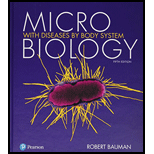
Concept explainers
(1)
To determine:
The aspect of the infection that caused Leslie to suffer anaemia, jaundice and fatigue, the reason why penicillin does not work for treating babesiosis and the number of legs in adult vector of babesiosis.
Case summary:
Leslie hated being sick and it all started with headache, muscle pains and sore joints on a fine day. Six weeks ago, a small deer tick (Ixodes scapularis) had taken a blood meal from Leslie’s leg. Leslie was unaware of the attack since the tick was so small and the bite was painless. She was also not aware that the tick had infected her with an apicomplexan
(2)
To determine:
The reason why penicillin does not work for treating babesiosis.
Case summary:
Leslie hated being sick and it all started with headache, muscle pains and sore joints on a fine day. Six weeks ago, a small deer tick (Ixodes scapularis) had taken a blood meal from Leslie’s leg. Leslie was unaware of the attack since the tick was so small and the bite was painless. She was also not aware that the tick had infected her with an apicomplexan parasite, Babesia microti, normally found in mice. Leslie became anaemic, jaundiced, fatigued and depressed and she was losing weight. As she became weaker, she had trouble catching her breath, and within a week, her kidneys began to fail followed by intermittent fever, shaking chills, drenching sweat, nausea and anorexia. However, with intensive medical care and use of antimicrobials such as atovaquone, azithromycin, clindamycin, and quinine, she felt better. The number of reported cases of babesiosis has quadrupled in the past decade, mainly because its tick vector that has an expanded range resulting from climate change.
(3)
To determine:
The number of legs in the adult vector of babesiosis.
Case summary:
Leslie hated being sick and it all started with headache, muscle pains and sore joints on a fine day. Six weeks ago, a small deer tick (Ixodes scapularis) had taken a blood meal from Leslie’s leg. Leslie was unaware of the attack since the tick was so small and the bite was painless. She was also not aware that the tick had infected her with an apicomplexan parasite, Babesia microti, normally found in mice. Leslie became anaemic, jaundiced, fatigued and depressed and she was losing weight. As she became weaker, she had trouble catching her breath, and within a week, her kidneys began to fail followed by intermittent fever, shaking chills, drenching sweat, nausea and anorexia. However, with intensive medical care and use of antimicrobials such as atovaquone, azithromycin, clindamycin, and quinine, she felt better. The number of reported cases of babesiosis has quadrupled in the past decade, mainly because its tick vector that has an expanded range resulting from climate change.
Want to see the full answer?
Check out a sample textbook solution
Chapter 21 Solutions
Microbiology with Diseases by Body System (5th Edition)
- In one paragraph show how atoms and they're structure are related to the structure of dna and proteins. Talk about what atoms are. what they're made of, why chemical bonding is important to DNA?arrow_forwardWhat are the structure and properties of atoms and chemical bonds (especially how they relate to DNA and proteins).arrow_forwardThe Sentinel Cell: Nature’s Answer to Cancer?arrow_forward
- Molecular Biology Question You are working to characterize a novel protein in mice. Analysis shows that high levels of the primary transcript that codes for this protein are found in tissue from the brain, muscle, liver, and pancreas. However, an antibody that recognizes the C-terminal portion of the protein indicates that the protein is present in brain, muscle, and liver, but not in the pancreas. What is the most likely explanation for this result?arrow_forwardMolecular Biology Explain/discuss how “slow stop” and “quick/fast stop” mutants wereused to identify different protein involved in DNA replication in E. coli.arrow_forwardMolecular Biology Question A gene that codes for a protein was removed from a eukaryotic cell and inserted into a prokaryotic cell. Although the gene was successfully transcribed and translated, it produced a different protein than it produced in the eukaryotic cell. What is the most likely explanation?arrow_forward
- Molecular Biology LIST three characteristics of origins of replicationarrow_forwardMolecular Biology Question Please help. Thank you For E coli DNA polymerase III, give the structure and function of the b-clamp sub-complex. Describe how the structure of this sub-complex is important for it’s function.arrow_forwardMolecular Biology LIST three characteristics of DNA Polymerasesarrow_forward
- Lifetime Physical Fitness & WellnessHealth & NutritionISBN:9781337677509Author:HOEGERPublisher:Cengage
 Medical Terminology for Health Professions, Spira...Health & NutritionISBN:9781305634350Author:Ann Ehrlich, Carol L. Schroeder, Laura Ehrlich, Katrina A. SchroederPublisher:Cengage Learning
Medical Terminology for Health Professions, Spira...Health & NutritionISBN:9781305634350Author:Ann Ehrlich, Carol L. Schroeder, Laura Ehrlich, Katrina A. SchroederPublisher:Cengage Learning  Comprehensive Medical Assisting: Administrative a...NursingISBN:9781305964792Author:Wilburta Q. Lindh, Carol D. Tamparo, Barbara M. Dahl, Julie Morris, Cindy CorreaPublisher:Cengage Learning
Comprehensive Medical Assisting: Administrative a...NursingISBN:9781305964792Author:Wilburta Q. Lindh, Carol D. Tamparo, Barbara M. Dahl, Julie Morris, Cindy CorreaPublisher:Cengage Learning





